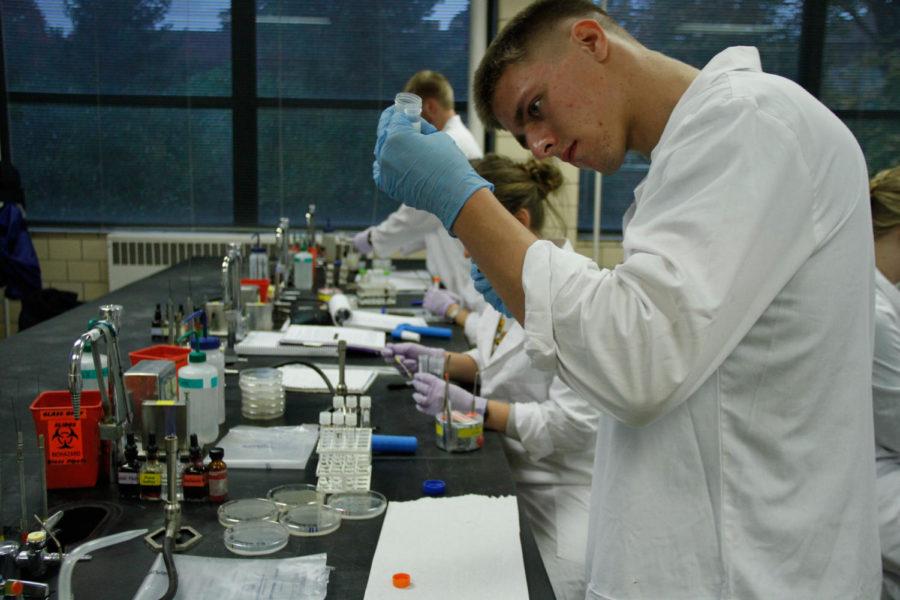Delving into the unknown
October 3, 2014
This semester, microbiology students are digging in the dirt to find antimicrobial compounds that were previously unknown, in the hopes of finding a way to combat antibiotic-resistant bacteria.
The Small World Initiative, a Yale Project involving 46 schools, is in its second year of operation.
Claudia Lemper, microbiology lecturer, was looking to develop upper level classes-microbial physiology as well as genetics and diversity-that synthesize soil research and antibiotics. Over the summer she found the Small World Initiative and thought it was a perfect project for students.
Recently President Obama signed an executive order declaring antibiotic-resistant drugs a threat to national security and the economy.
There is a call from U.S. legislature to research and find more antibiotics to keep up resistant bacteria.
“The biggest thing for the students is they’re part of pop culture of the science world and they can see that impact,” Lemper said.
In order to join the Small World Initiative, Iowa State agreed to complete the project in its entirety [getting students to sequence and identify organisms], pay for supplies and academic assessments.
Dr. Joan Cunnick, professor in animal science and professor in charge of the undergraduate microbiology program, saw Lemper’s enthusiasm for the project and helped Lemper to secure funding from the Microbiology department for student supplies.
“We’re testing this out, there’s a lot of different teaching styles and it’s not going fit with everyone’s teaching and learning style but I think it’s worth trying,” Cunnick said.
The assessments are meant to reveal students’ attitudes toward science and understanding of science. Ultimately, the project’s goal is to engage students and encourage them to pursue careers in in STEM (science, technology, engineering and mathematics) occupations.
Cayla Witte, senior in biology and student in Microbiology 302L, knows a lot of research has to go into finding new antibiotics and is excited to work on the project in her 302 lab.
“I love the idea that the Small World Initiative project is giving students the opportunity to do real research that has the potential to have a real effect on medicine,” Witte said.
Students are looking for antimicrobial compounds that may be unknown. They are then tasked to come up with variables to characterize the compound—emphasizing the critical thinking approach.
Lemper said this isn’t a “cookbook” lab where they’re given specific instructions on how to complete the lab, nor does Lemper know the outcome of the lab.
“The whole project is getting students to make decisions based on their knowledge, and fail,” Lemper said.
Lemper said she wants to students to understand that most of science is trouble-shooting and repeating experiments—there is no right way to make it work.
“There’s no bad idea, there’s no wrong answer, there isn’t a perfect way,” she said.
Microbes secrete antimicrobial substances that inhibit growth of other organisms. Lemper said scientists aren’t sure of whether this is a defense mechanism or a communication method.
The students will test their compounds on six escape pathogens to see if they have properties to make them good antibiotic candidates. The pathogens are common in hospitals—E. coli, salmonella and staphylococcus.
A student from Southern Florida found a super-producer (microbe that secretes a powerful antimicrobial compound) near the ocean. The microbe’s use is being discussed with pharmaceutical companies.
“Fingers crossed that Iowa, the land known for rich soil, also contains the new super-microbe,” Witte said.
Witte collected her sample from soil underneath a pine tree between the Campanile and Carver Hall.
Lemper wants students to stay interested in science as well as see the direct avenues where they can go for employment in STEM careers.
“If we can get this in the lower-levels and get students excited, it will continue in the upper-levels,” Lemper said.
Currently, Lemper is incorporating the project into a section of microbiology 302L and 440. Her 440 class will take the project further to identify the specific molecules of the antimicrobial compounds with chemistry students.
She hopes students in the 300 level lab can save their compounds for future use in microbiology 440.
“I think the students will have a good time learning and I’m hoping that they will be able to retain that knowledge longer than in a regular lab because they were more involved in the project,” Cunnick said.
Students in microbiology 302L will be presenting their findings in a poster session before Thanksgiving break to people who are not studying microbiology in order to test their abilities to teach others and spread the word about antimicrobial research.

















